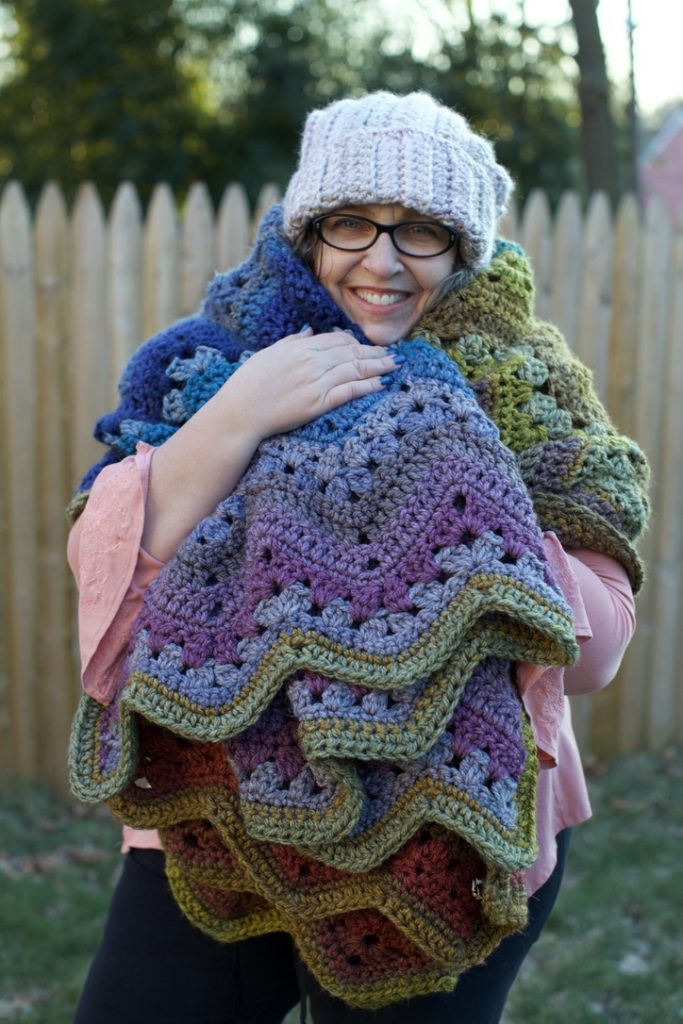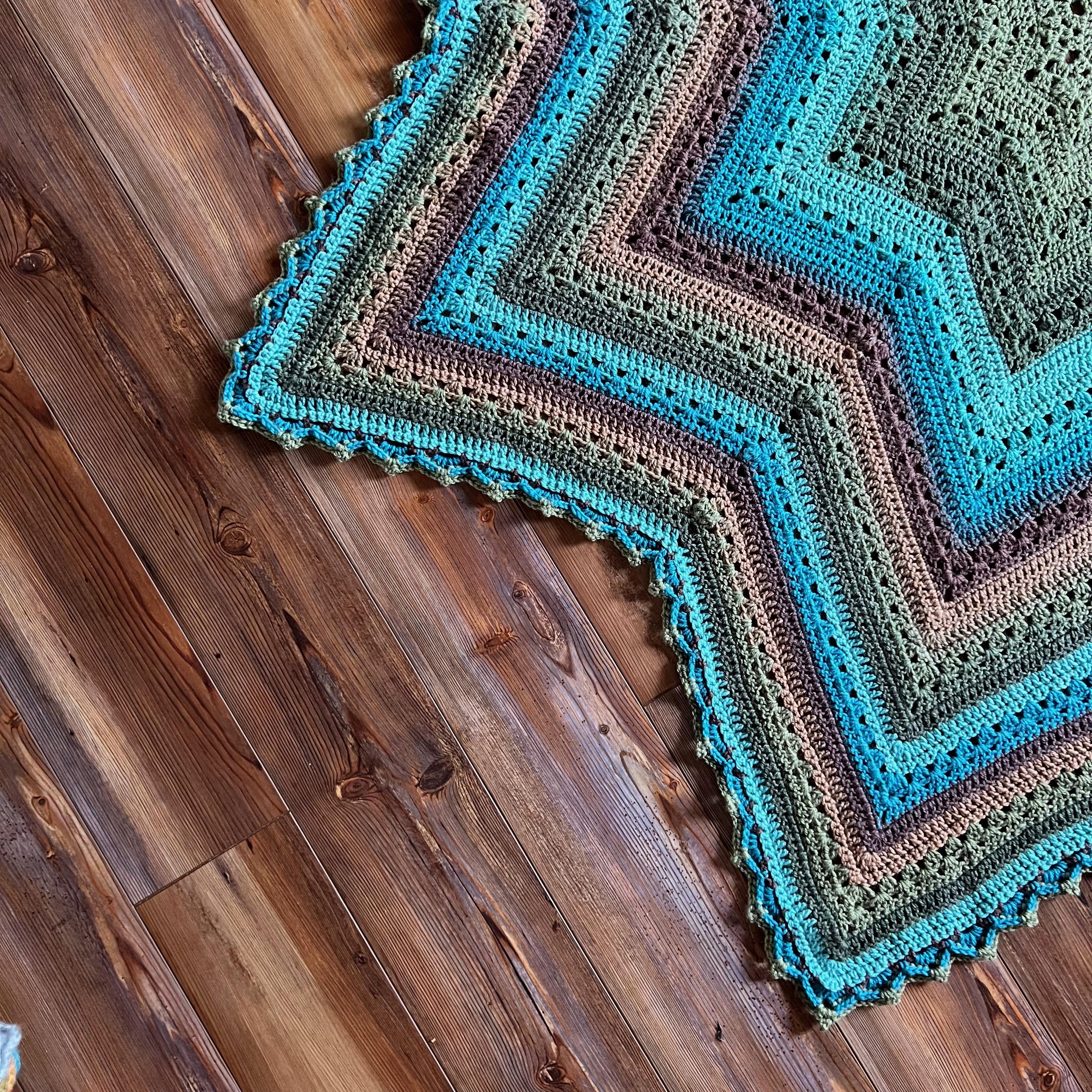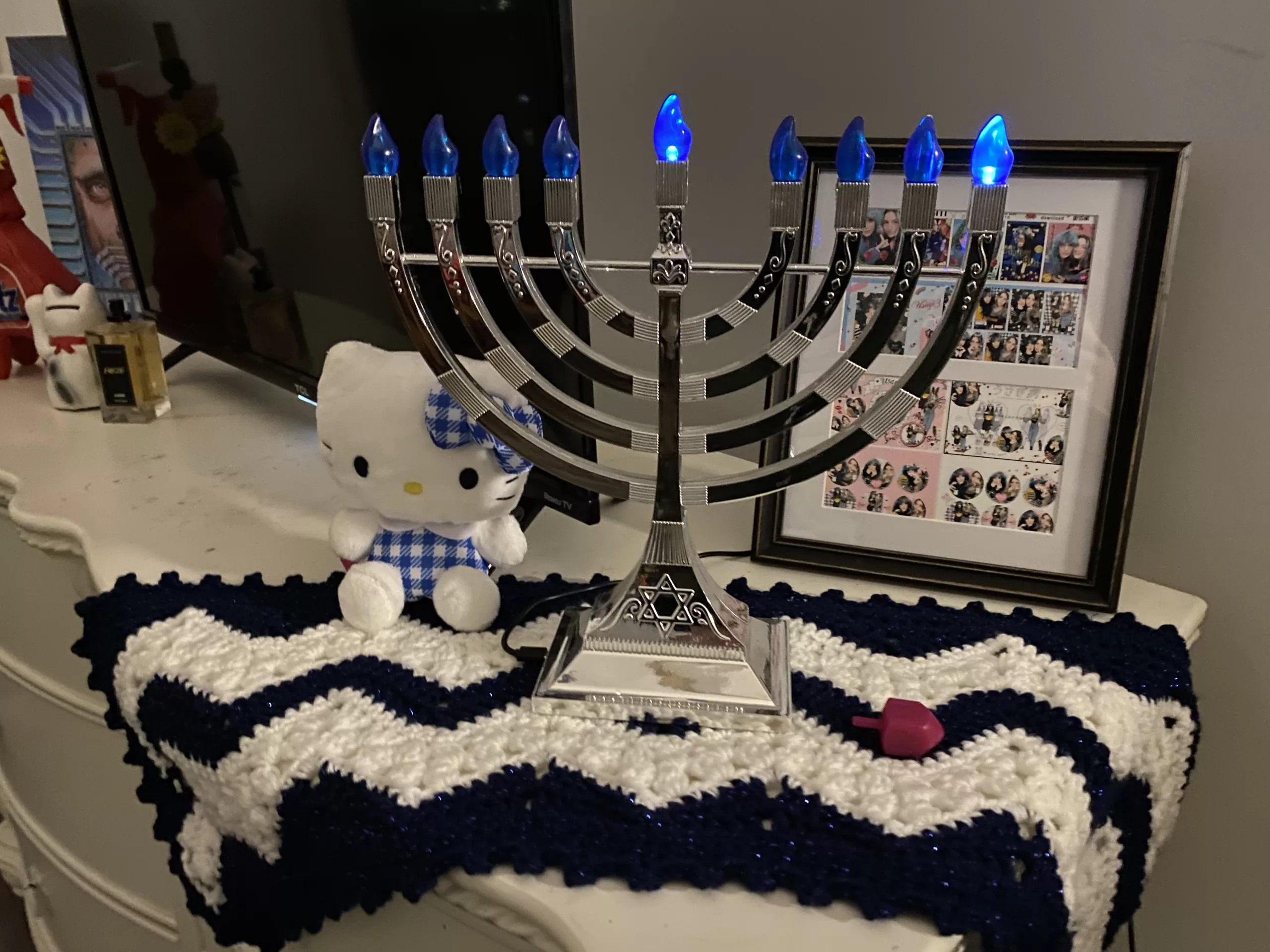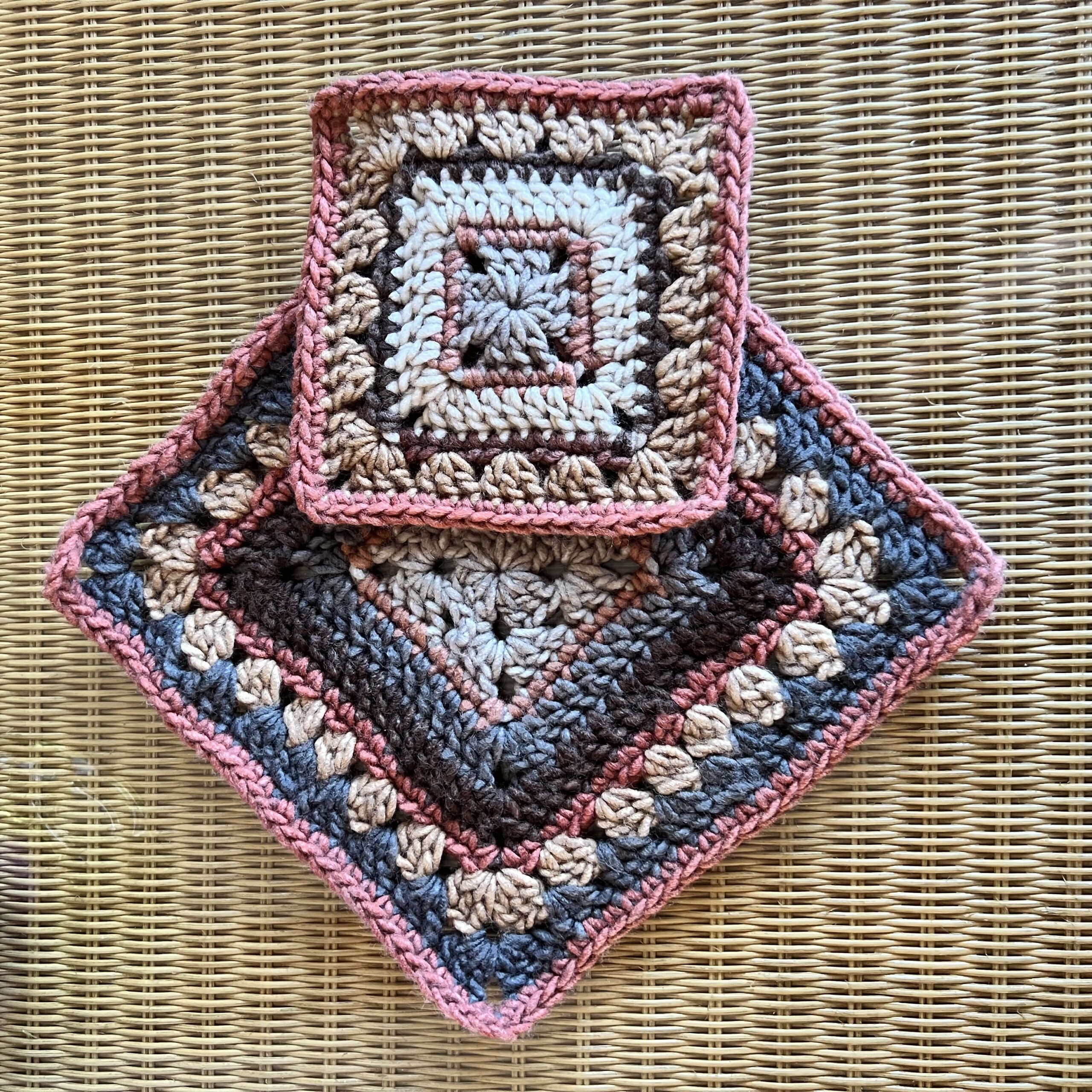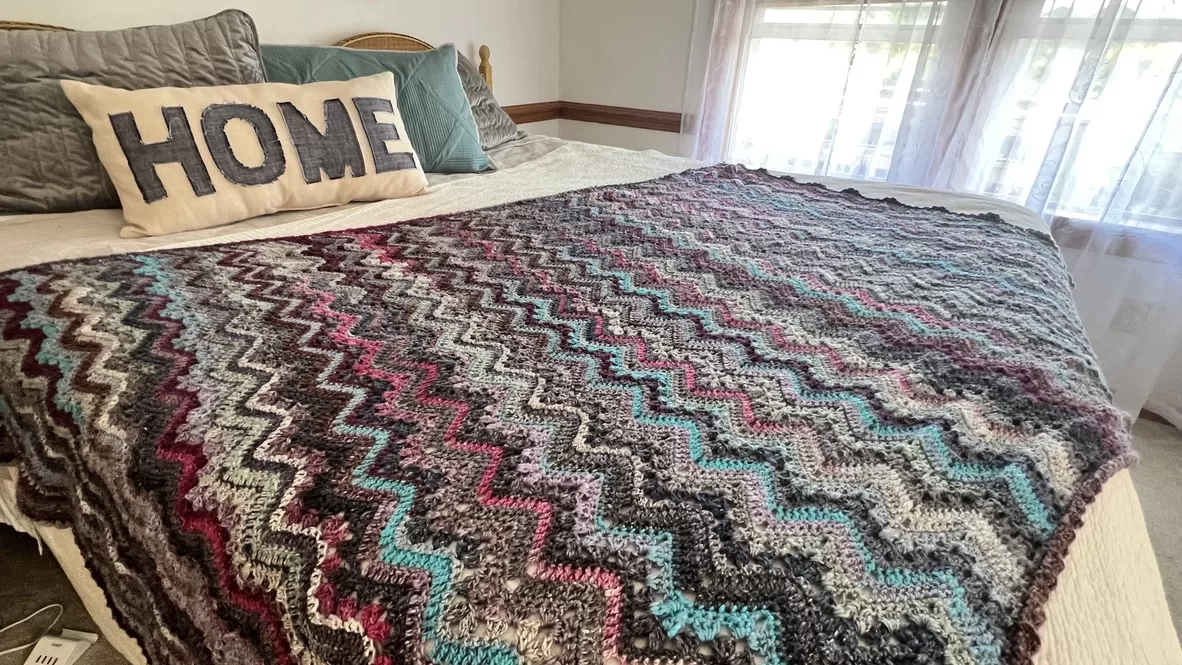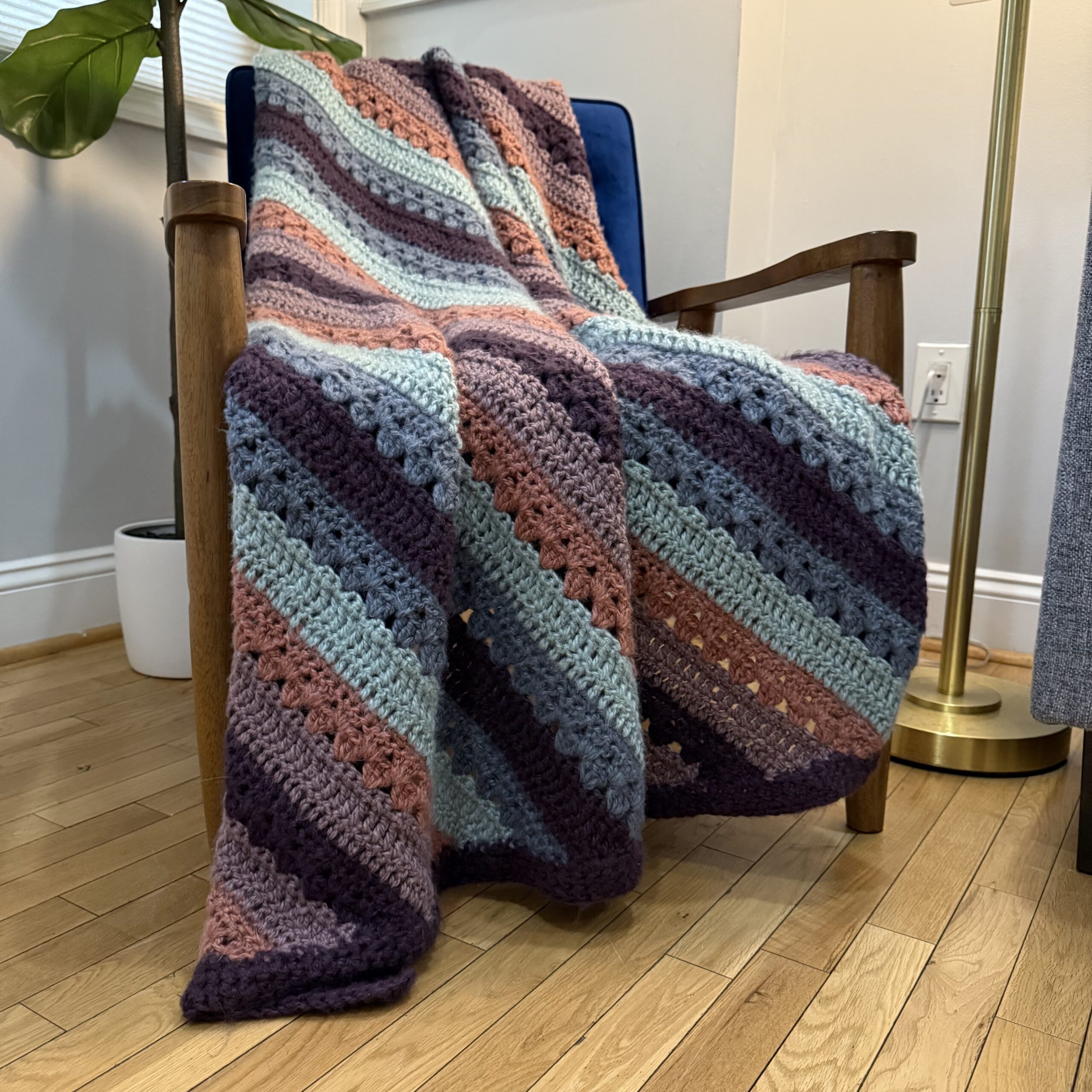6-Day Great Granddaddy Blanket
6-Day Great Granddaddy Blanket
A variation of the classic crochet pattern the
6-Day Kid Blanket by Betty McKnit
Introduction
This pattern is for a continuous granny rectangle blanket using the 6-Day Crochet series of stitches. It is worked from the center out and can be made as small or as large as you like. It has a simple, practical, perfect-for-grandad edge.
If you would like a continuous Granny Square please see the 6-Day Great Granny Blanket, and for a longer rectangle try the 6-Day Great Granddaddyo Blanket.
This page contains affiliate links. If you click these links and buy something on the page they take you to, I may, at no additional cost to you, earn a commission. I only affiliate with products and companies I feel good about. Thank you for your support!
This pattern is provided free with advertisements on this page. If you would like an ad-free .pdf, you can purchase one at the bottom of the page. The .pdf is the same as this pattern, with the exception of the ads.
Details
US Terminology with UK Conversions
Skill Level: Easy
Gauge: This pattern can be made with any yarn and corresponding hook of an appropriate size to achieve the tension you prefer. You do not have to match my gauge.
Gauge for yarn shown 16 sts x 17 rows in sc
Hook: 4.5mm (H/7) for yarn shown, choose hook appropriate for your yarn.
Choose a hook appropriate for your yarn, and on .5 mm larger for your starting chain. Check the chart at the end of this pattern for suggest hook sizes for different weights of yarn.
Finished Size: Variable. Blanket shown is 38”x45”
Materials
Yarn: This pattern is meant to be adaptable and work with many different yarns. The blankets in this pattern was made with Caron Skinny Cakes, #3 weight “Light” 100% acrylic in the color Peach Mint. Color changes were controlled to avoid mid-row changes.
Yardage Estimates
DK or #3 weight – 1600-2200 yards for a baby blanket, 2800-3800 yards for a full-sized blanket.
Worsted or #4 weight – 1500-1750 yards for a baby blanket and 3000-3500 yards for a full-sized blanket.
Bulky or #5 weight yarn -1300-1450 yards baby blanket and 2500-3000 yards for a full-size blanket
Super Bulky or #6 weight – 1250-1500 yards baby blanket and 2500-3000 yards for a full-size blanket
Cake (Self-Striping) Yarn
This blanket looks best with intentional color changes, as
mid-row color changes stand out. If you don’t want to be bothered to control the colors for a large project, I suggest doing it for the first 8-10 rounds. You will need extra yardage if you are using cake yarn and controlling the colors.
| US terms abbreviation | UK terms abbreviation |
| single crochet sc | double crochet dc |
| half double crochet hdc | half treble crochet htr |
| double crochet dc | treble crochet tr |
Abbreviations
ch: chain
dc: double crochet
dc3tog: double crochet 3 together cluster
hdc: half double crochet
sc(s): single crochet(s)
sdc: standing double crochet
sl st: slip stitch
sp(s): space or spaces
ssc: standing single crochet
st(s): stitch(es)
x: times
Special Stitches:
dc3tog: (cluster): yo, insert hook in next st/sp, yo, pull up a loop, yo, pull through 2 loops, [yo, insert hook into same st/sp, yo, pull up a loop, yo, pull through two loops] 2 times. yo and pull through 4 loops.
standing double crochet: pull up the working loop to the height of a double crochet stitch, wrap the loop around your hook, holding it against the hook with your finger, pull up a loop in the space or stitch indicated, yarn over and pull through the loop on the hook and under the first twist around the hook, yarn over and pull through two loops on the hook.
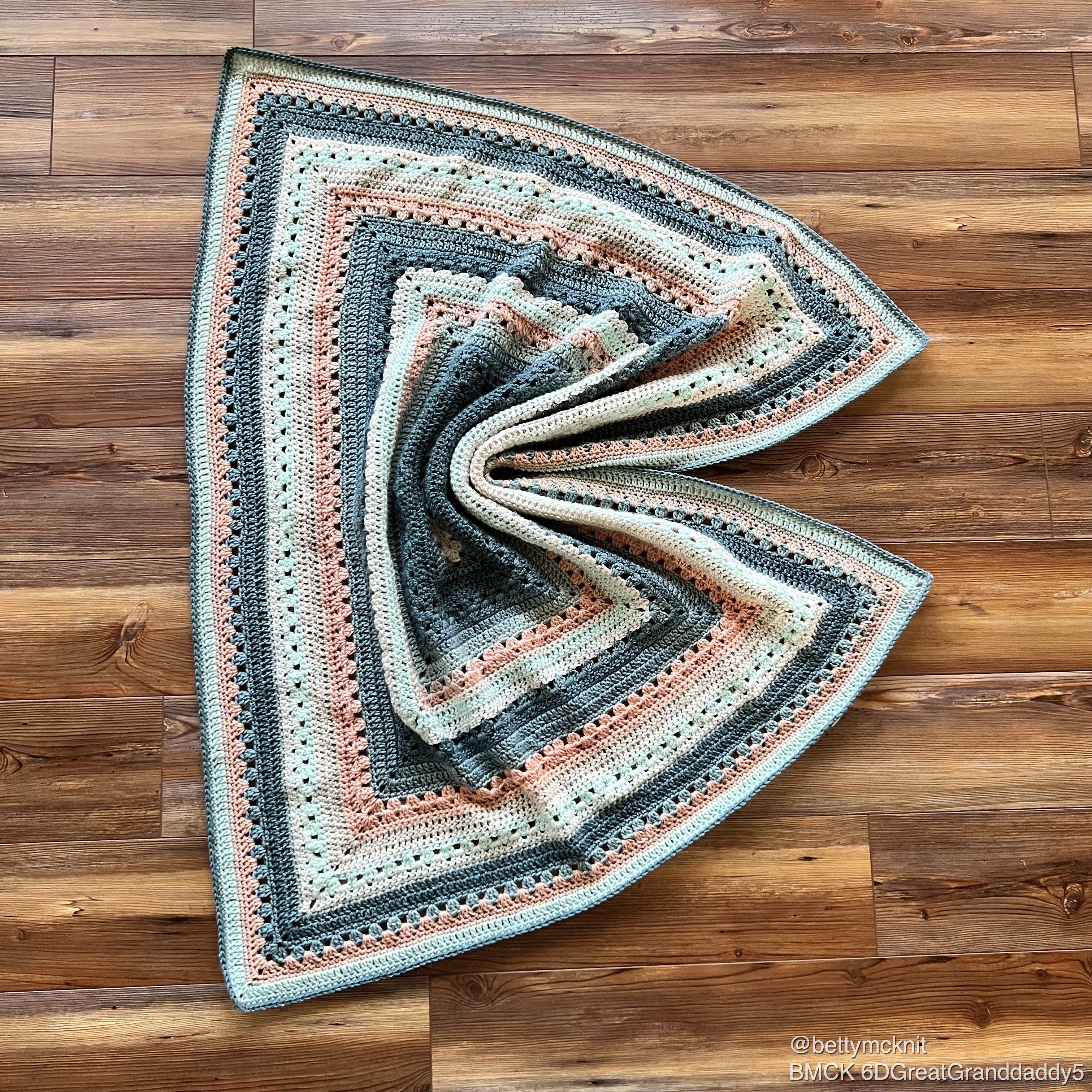
Repeats
( ) Work in the same st or sp.
[ ] Repeat everything within the brackets the indicated number of times.
* indicates the start of a repeat
** indicates end of repeat on last repeat only.
Stitch Counts
- Stitch counts between < >
- Stitch counts on subsequent repeats of the pattern are given in parentheses like so: repeat 1 (repeat 2, repeat 3, repeat 4…) It will help to print this pattern out and cross out the numbers you don’t need, and cross off the numbers of each round as you complete them.
- I’ve given stitch counts for ten repeats. You don’t have to do them all, and you can do more if you like.
Stitch Counts
- Stitch counts between < >
- Stitch counts on subsequent repeats of the pattern are given in parentheses like so: repeat 1 (repeat 2, repeat 3, repeat 4…) It will help to print this pattern out and cross out the numbers you don’t need, and cross off the numbers of each round as you complete them.
- I’ve given stitch counts for ten repeats. You don’t have to do them all, and you can do more if you like.
Does it Really Only Take Six Days?
All of my patterns that use the same six rows alternating rows of sc, dc, and clusters, with or without chevrons, is named 6-Day Crochet. The name of this pattern comes from the original 6-Day Kid Blanket, which was toddler sized and made with chunky yarn, and took me an easy six days to make. This variation uses the same stitches as that original pattern, but you can use any yarn and make it any size you want, so whether you can meet the six day deadline will depend on several factors, but it is 100% possible to complete a large blanket in six days. You will love how fast the 6-Day Crochet Projects work up.
Tips for Completing in Six Days
To complete this project in six days, it will depend on how fast you crochet, what kind of yarn you use, and what size blanket you want to make. Most crocheters will need to work 2-4 hours each day. For this blanket, 5 or 6 weight yarn will be the best option for 6-Day completion of larger blankets. On the first day, do the Setup Rounds and the first two repeats, after that do 1-2 repeats per day. Blankets with more than twelve pattern repeats will probably take longer than six days, or more than 4 hours per day to complete.
About the Numbering of Rounds
This pattern begins with a series of setup rounds, which you will only work once, and when they are complete, you will proceed to the six repeating rounds that make up the 6-Day Crochet stitches. The 6-Day Crochet repeating rows/rounds are always numbered 2-7 to provide consistency across all of the 6DKB pattern variations. The cluster rows are always Row or Round 2 and 3, the dc rows are always Row or Round 5 and 6, and the sc rows are always Row or Round 4 and 7. This makes it easier for you to memorize the patterns, for me to keep track of the different patterns when answering your questions, and to adapt any 6-Day Crochet patterns to the Snowflake Effect, Viral Stripes, Sweetheart Stripe, Popsicle Effect, Ridgy Didge, or the original Vivid Chevrons.
In this particular pattern, the repeating rounds pick up after the setup rounds at Round 8, and the first repeating round begins at Round 3. Proceed to Rounds 4, 5, 6, and 7 and then 2, and then back to Round 3 and repeat that sequence until your blanket reaches the size you like, ending on Round 4 or 7. You will be guided to work the rows in the proper order so don’t overthink the change in sequence or let the numbers throw you off. Once you are familiar with 6-Day Crochet patterns, it will make sense.
Changing Colors
No two 6-Day Crochet Blankets are alike. 6-Day Crochet patterns can take on many different looks depending on which row or rounds the color changes fall on. This pattern does not give specific color changes, but if you would like to reproduce some of the most well-known 6DKB stripes, see my article “No Two 6-Day Kid Blankets are Alike” for more information about how to to alter this pattern to create different looks.
The first 6-9 rows of this version look best when the yarn does not change colors in the middle of a round, so if you are using cake yarn, you may want to purchase an extra cake so you can cut colors for at least the first few rows.
Change colors by fastening off the old color and starting the new color with a standing stitch. I prefer to start new colors at the opposite corner of the blanket each time to make ends less visible and easier to weave in.
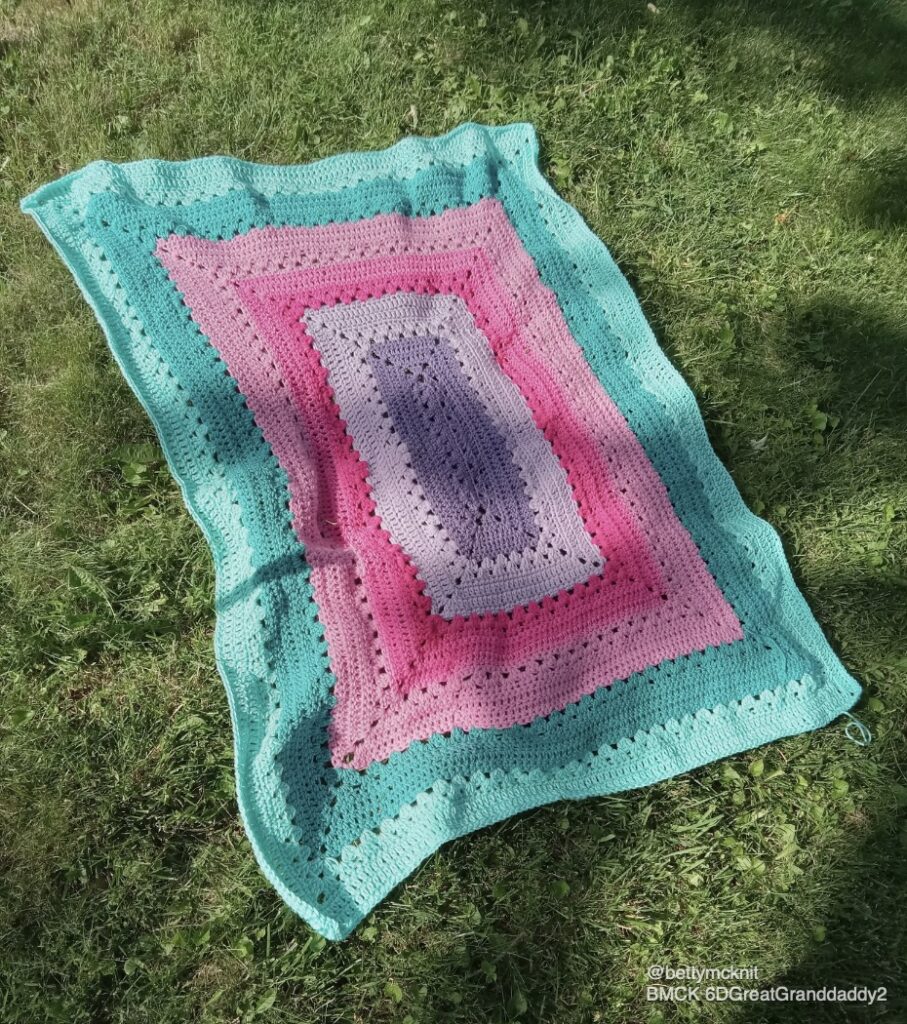
Notes
- If you are changing colors on every round after the setup rounds, you can begin and end your rounds anywhere as long as you put all the stitches in their proper places and have the correct number of stitches on each side of the work.
- Take care not to miss the first stitch after the corner chains.
- I recommend turning the work at least once per repeat. I’ve written the pattern to turn on Round 4; you can actually turn on any round you like.
- Treat hdc and ch 1+hdc at the joining of rounds as corner ch-2 or ch-3 sps respectively. Mark them.
- Put a stitch marker in the first and last stitch of each round to help find the corner space. Avoid mistaking the hdc join as a stitch and working into it, creating additional stitches.
- Mark the center sc on each side on Round 7 to help you find the center of the side. When you sk 1 between the dc3tog, you should be skipping the marked stitch.
- Left handed crocheters may find that the short and long sides of the blanket show up in the opposite order as right handed crocheters. You may need to transpose short side and long side numbers.
How to Resize
Measure your work after Setup Round 1. This length will be the difference between the length and width of your finished project. As your blanket grows, the difference between the length and width will remain constant at this measurement, so you can stop when you have reached the desired width. If you measure after Setup Round 1 and decide you would like a more rectangular blanket with more length, restart with a higher chain count in a multiple of 6+4. If you would like a shorter blanket, restart with a lower chain count. Different weights of yarn will have a different size ratio; check the sizing chart at the end of this pattern for size approximations for different weights of yarn.
There is an exclusive version of this pattern in my membership community, The Betty McKnitiverse, that gives instruction and counts for four different lengths. Join for access to this and other exclusive pattern variations, new pattern pre-releases, project courses, community zoom calls and classes.

Begin
With larger hook, ch 28 (multiple of 6 + 4).
Setup Round 1: starting in 4th ch from hook, working in third loop (back bump) of chain, sc in next 25 sts, ch 3, rotate the work, sc across the other side of 25 foundation chs. <50 sc, 2 ch-3 sps>
The length of your work at this point will be the difference between the length and width of your finished project.
Switch to smaller hook.
Setup Round 2: sl st into ch-3 sp, sdc, 2 dc in same sp. (ch 3, 3 dc) in same ch-3 sp, *[sk 2, 3 dc in next st] 3x, sk 2, dc3tog in next st, sk 1, dc3tog, [sk 2, 3 dc in next st] 3x, sk 2, ** ([3 dc, ch 3] 2x, 3 dc) in ch-3 sp, repeat from * ending at **, 3 dc in ch-3 sp (mark the last dc), ch 1, join with hdc to sdc. <18 sets of 3 dc, 4 dc3tog, 4 corner sps>
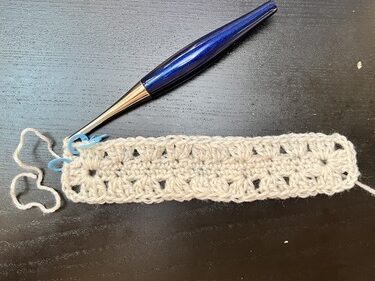
Setup Round 3: sdc into the corner sp (around the hdc you made to join, here and throughout), 2 dc in same sp, (3 dc, ch 3, 3 dc) in next ch-3 sp, 3 dc in next 4 sps, dc3tog in next sp (between 2 dc3tog) 3 dc in next 4 sps, (3 dc, ch 3, 3 dc) in next 2 corner ch-3 sps, 3 dc in next 4 sps, dc3tog in next sp (between 2 dc3tog) 3 dc in next 4 sps, 3 dc in first corner sp, ch 1, join with hdc to sdc. <24 sets of 3 dc, 2 dc3tog, 4 corner sps>
Turn
Setup Round 4: ch 1, sc in corner sp, sc in each st around, work (sc, ch 2 sc) in next three corner ch-sps, sc in first corner sp, join with hdc to first sc. <33 sc on long sides and 8 sc on short sides>
Setup Round 5: sdc into the corner sp, dc in same sp, dc in each st around working (2 dc, ch 3, 2 dc) in next 3 corner sps, 2 dc in first corner sp, ch 1, join with hdc to sdc. <37 dc on long side, 12 dc on short sides>
Setup Round 6: sdc into the corner sp, dc in same sp, dc in each st around, working (2 dc, ch 3, 2 dc) in next 3 corner sps, 2 dc in first corner sp, ch 1, join with hdc to sdc. <41 dc on long sides, 16 dc on short sides>
Setup Round 7: ch 1, sc into corner sp, sc in each st around, work (sc, ch 2, sc) in next 3 corner sps, sc in first corner sp, join with hdc to first sc. <43 sc on long sides, 18 sc on short side>
Mark the 22nd sc on the long sides and the10th st on the short sides.
Setup Round 8: sdc into the corner sp, 2 dc in same sp, *[sk 2, 3 dc in next st] 6 times, sk 2, dc3tog in st before marker, sk 1 (should be the marked st), dc3tog in next st, [sk 2, 3 dc in next st] to 2 sts before the corner, sk 2 ** (3 dc, ch 3, 3 dc) in corner ch-2 sp, [sk 2, 3 dc in the next st] twice, sk 2, dc3tog, sk 1, dc3tog, [sk 2, 3 dc in the next st] to one st before corner, sk 1, (3 dc, ch 3, 3 dc) in corner ch-2 sp, repeat from * around, ending last repeat at **, 3 dc in first corner sp, ch 1, join with hdc to sdc. <40 3-dc clusters, 8 dc3tog, 4 corner sps>
Setup Rounds complete. Round 3 is next.
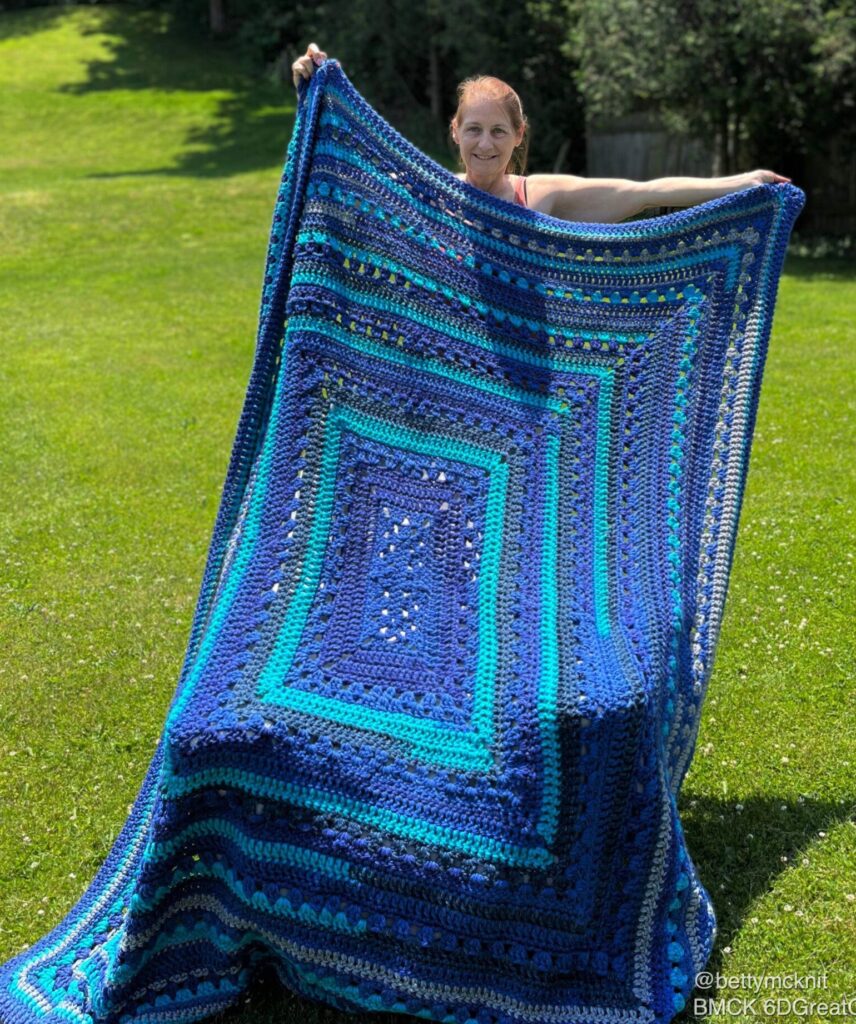
Round 3: sdc, 2 dc in same sp, *3 dc in next 7 (6, 13, 12, 19, 18, 25, 24, 31, 30) sps, (dc3tog between 2 dc3tog, 3 dc in each sp to corner, (3 dc, ch 3, 3 dc) in corner ch-3 sp, 3 dc in next 3 (10, 9, 16, 15, 22, 21, 28, 27, 34) sps, dc3tog bet 2 dc3tog, 3 dc in each sp to corner, ** (3 dc, ch 3, 3 dc) in corner ch-3 sp, repeat from * to **, 3 dc in ch-3 sp, ch 1, join with hdc to sdc. <48 (72, 96, 120, 144, 168, 192, 216, 240, 264, 288) sets of 3-dc clusters, 4 dc3tog, 4 corner sps>
There will always be one more space than cluster between the corner and the dc3tog from the previous round, and three more than the previous repeat.
Turn
Round 4: ch 1, sc in corner sp, sc in each st around, work (sc, ch 2 sc) in next three corner ch-sps, sc in first corner sp, join with hdc to first sc. <51 (69, 87, 105, 123, 141, 159, 177, 195, 213) sc on long sides and 27 (45, 63, 81, 99, 117, 135, 153, 161, 179) sc on short sides>
The number of sc on each side increases by 18 on each repeat.
Round 5: sdc into the corner sp, dc in same sp, dc in each st around working (2 dc, ch 3, 2 dc) in next 3 corner sps, 2 dc in first corner sp, ch 1, join with hdc to sdc. <55 (73, 91, 109, 127, 145, 163, 181, 199, 207) dc on long side, 31 (49, 67, 85, 103, 121, 139, 157, 175, 193) dc on short sides>
Round 6: sdc into the corner sp, dc in same sp, dc in each st around, working (2 dc, ch 3, 2 dc) in next 3 corner sps, 2 dc in first corner sp, ch 1, join with hdc to sdc. <59 (77, 95, 113, 131, 149, 157, 175, 193, 211) dc on long side, 35 (53, 71, 89, 107, 125, 143, 161, 179, 197) dc on short sides>
The number of dc on each side increases by 18 on each repeat.
Round 7: ch 1, sc into corner sp, sc in each st around, work (sc, ch 2, sc) in next 3 corner sps, sc in first corner sp, join with hdc to first sc. <61 (79, 97, 115, 133, 151, 169, 187, 205, 223) sc on long sides and 37 (55, 73, 91, 109, 127, 145, 163, 181, 199) sc on short sides>
Mark the center sc on each side.
Remember that the rounds are numbered according to the 6-Day Crochet pattern. Proceed to Round 2.
Round 2: sdc into the corner sp, 2 dc in same sp, *[sk 2, 3 dc in next st] to 3 sts before marker, sk 2, dc3tog in st before marker, sk marked st, dc3tog in next st, [sk 2, 3 dc in next st] to 2 sts before the corner, sk 2 ** (3 dc, ch 3, 3 dc) in corner ch-2 sp, repeat from * around, ending last repeat at **, 3 dc in first corner sp, ch 1, join with hdc to sdc. <10 (13, 16, 19, 22, 25, 28, 31, 34, 37) sets of 3 dc clusters on each side of the dc3tog on long sides, 6 (9, 12, 15, 18, 21, 24, 27, 30, 33) on short sides>
On each repeat, the number of 3 dc clusters on either side of the dc3togs increases by 3 on each repeat.
Repeat these six rounds — 3, 4, 5, 6, 7, 2 — until your work is the size you desire. Do not repeat the Setup Rounds. End on Round 4 or 7.
I’ve given you stitch counts for ten repeats. You don’t have to do them all, and you can do more if you want to.
Proceed to Border.

Border
Work each border round in a different color.
Border Round 1: Join to any st, sc in each stitch around, making (sc, ch 2, sc) in each corner st. Join with sl st to first sc. Fasten off.
Border Round 2: Join with sdc to any st, dc in each st around working 5 dc in each corner ch-2 sp. Join to first dc. Fasten off.
Border Round 3 and 4: repeat Border Round 1.
Fasten off. Weave in all ends.



Tested by members of the Betty McKnitiverse: Kathy Bertram, Jackie Blanchet, Amy Bryson, Diane “Dee Louise” Kagay, Genevieve Nelson, Pat Ojanen, and Deborah Shoemaker.
Beth McKee Elliott, also known as Betty McKnit, is a crochet and knitting designer, instructor, community leader, and Master Somatic Movement Therapist and Educator. Her signature style, 6-Day Crochet, is showcased in the viral crochet patterns the 6-Day Kid Blanket and 6-Day Star Blanket.
Beth/Betty is passionate about designing quick, adaptable, go-to crochet and knitting projects, and is committed to being accessible to assist crafters in bringing their dream projects to life.
She specializes in Somatic Crochet and Knitting, a mindfulness practice that combines crochet/knitting with body awareness techniques to prevent injury and promote well-being and creativity in crafting.
This pattern is the intellectual property of Beth McKee Elliott aka Betty McKnit®. This pattern, The 6-Day Kid Blanket, 6-Day Crochet™, 6-Day Star Blanket™, and all derivative works are protected by copyright. Publishing translations, corrections, variations, or tutorials of this pattern, online or elsewhere without written permission from the owner is a violation of copyright.
Items created with this pattern may be used for commercial sale with credit to Betty McKnit in your listing. Mass production is not permitted.
The 6-Day Crochet stitch pattern was inspired by “Vivid Chevrons” #110 from 200 Ripple Stitch Patterns by Jan Eaton.
Edging was inspired by ideas I found in Edie Eckman’s books “Around the Corner Crochet Borders” and “Every Which Way Crochet Borders.”
This page contains affiliate links. If you click these links and buy something on the page they take you to, I may, at no additional cost to you, earn a commission. I only affiliate with products and companies I feel good about. Thank you for your support!

An international community of yarnful makers and friends.
- New pattern pre-releases
- Exclusive patterns never released to the public
- Have access to Betty’s ad-free .pdf library of patterns (3-4 patterns/month)
- Access to Betty’s Design Workshop
- Uplevel your knitting and crochet skills
- Enjoy regular crochet alongs, knit alongs, and classes
- Make like-minded friendships during our weekly social and educational events
- Bonus content every month


